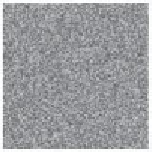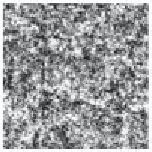Environmental Engineering Reference
In-Depth Information
pdf
p
d
f
p
d
f
0.6
0.6
60
30
0.3
0.3
0.0
φ
2
φ
2
φ
0.02
2
1
1
2
1
1
S
S
S
1
350
350
0.5
3
k
3
k
3
k
1
2
1
2
1
2
Figure 5.40. Example of patterns resulting from the numerical simulation of model
(
5.81
). The columns refer to 0, 50, and 100 time units. The parameters are
a
=
1,
c
=
1,
D
=
10, and
s
gn
=
10.
of
g
(
φ
) around zero:
1
1
2
2
+
3
c
2
φ
4
5
c
3
φ
6
c
φ
g
(
φ
)
=
=
1
−
−
+···
.
(5.83)
+
c
φ
2
8
16
Therefore, when
φ
is close to zero, the
φ
-dependent component tends to zero, but the
additive component remains [i.e.
g
(
φ
0
)
=
0] and is able to unlock the system from the
deterministic stable state
φ
0
, therebymaintaining the dynamics away from equilibrium
and allowing the spatial coupling to exert its pattern-inducing effect. From this point
of view, the mechanism of noise-induced pattern formation described in this section
is very similar to the one described in Sections
5.2
and
5.3
. However, the purely
multiplicative component of
g
is not secondary; in fact, it has the role of dimming the
noise effect far from
φ
0
, thereby hampering the divergence of the dynamical system
away from
φ
=
φ
0
. In other words, when
|
φ
|
is high, the function
g
(
φ
) tends to zero,
and the effect of noise on the dynamics of
tends to disappear; consequently the
deterministic component prevails and the system goes back to values of
φ
φ
close to
φ
0
. In this sense the dynamical role of the
φ
-dependent component of
g
(
φ
) resembles
3
in the deterministic Ginzburg-Landau model (see Subsection
the role of the term
−
φ
5.2.1
).






































Search WWH ::

Custom Search